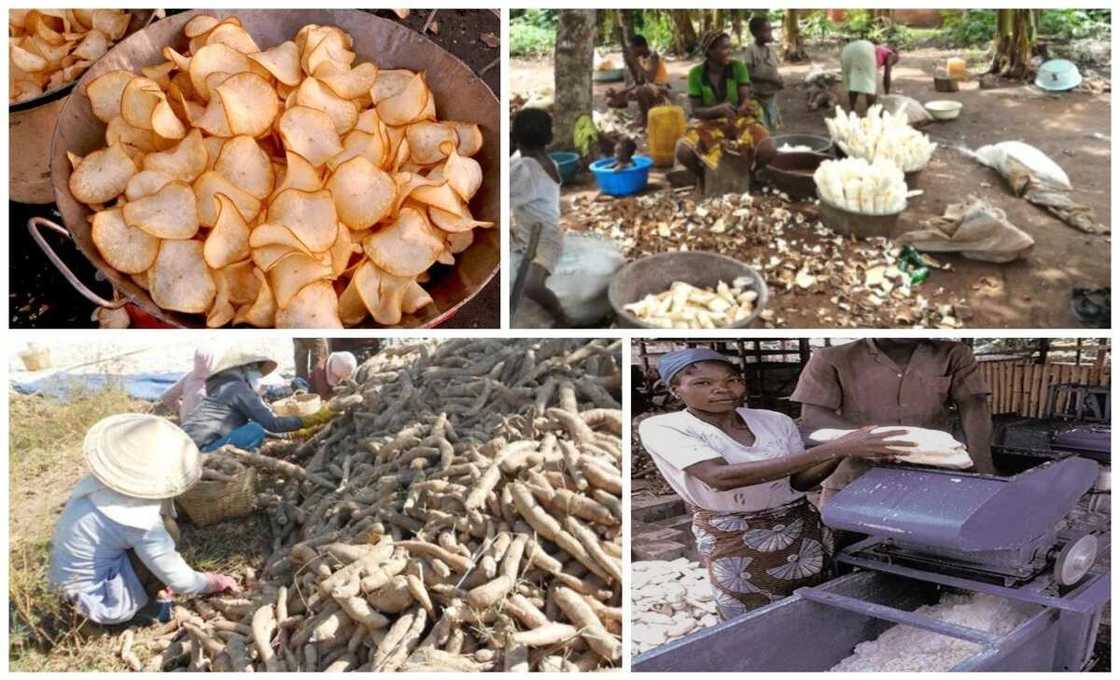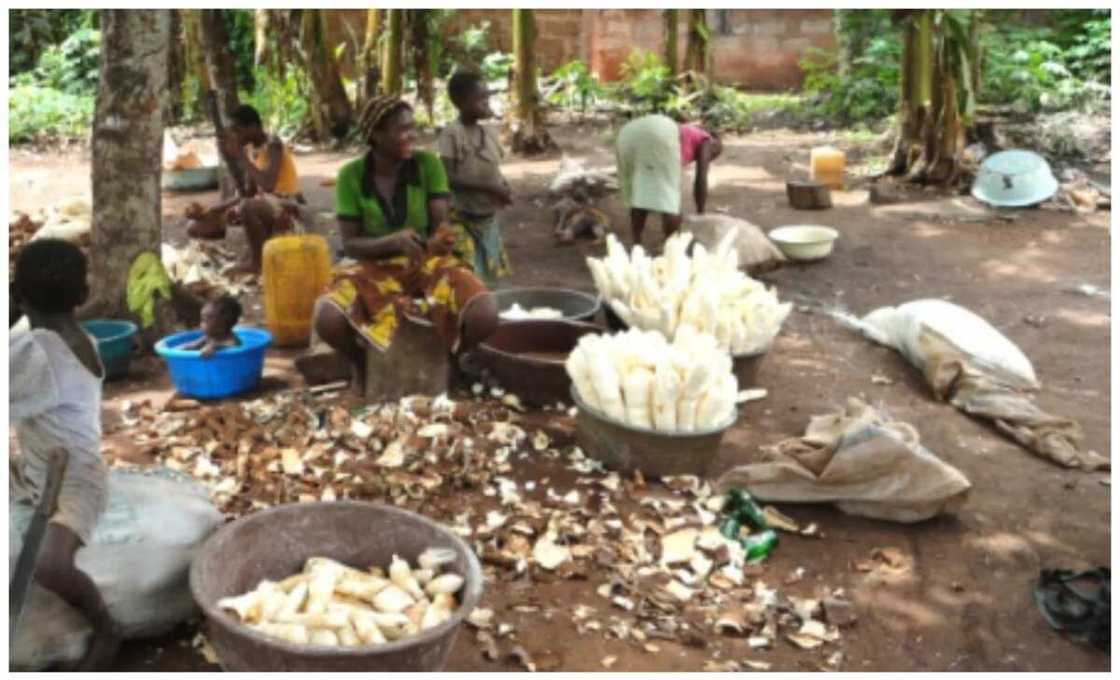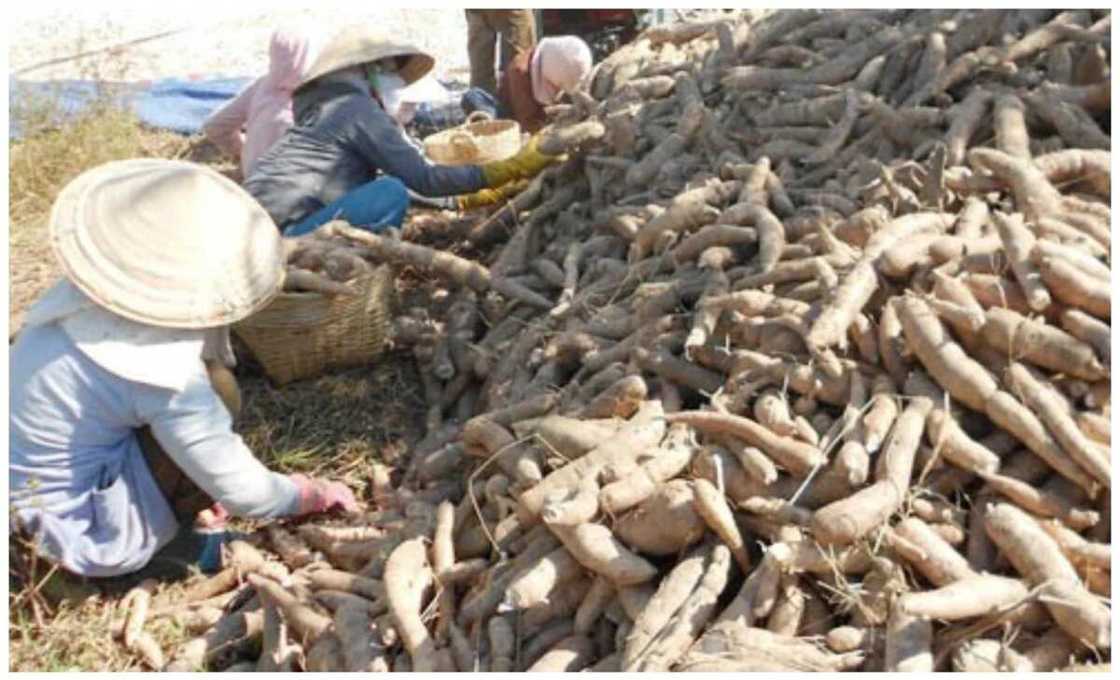How to generate huge income from cassava peels cake
Editor’s note: Mutiu Iyanda, the Legit.ng partner blogger, in this article explains how Nigerians could derive viable income from cassava peels cake.
His blogs are: www.infoprations.blogspot.com.ng, www.enterprations.com
He could also be contacted via: +2348141374490, +2348062544816.
More details in Legit.ng’s step-by-step guide for guest bloggers.
Cassava, a crop with more than 20 different names from different countries in the world, is a crisis crop. It is being dubbed an emergency crop on the basis of its expediency in solving man’s starvation when other crops such as yam, maize, rice, and wheat are insufficient during war, drought or low national incomes. The regime of former General Sanni Abacha is a typical example.

During his administration, many Nigerians ate cooked cassava with palm oil for the first time as against the traditional cassava flour and other by-foods associated with the crop. Beyond this, it has been discovered that cassava could lead to the production of several consumables, making it a crisis crop indeed.
READ ALSO: How to tap sustainable profits from Nigerian cities’ wastes
Across the regions, Garri is the most food Nigerians make from Cassava followed by Fufu/Akpu. For instance, Nigerians in south-west are known for consumption of lafun (Cassava flour). Those residing in south-south and south-east regions are famous for Akpu while northern Nigerians eat Abacha, the most.
Brazil, Indonesia, and Thailand are trailing Nigeria in terms of the commodity production in the world. In terms of metric tons, production of the Nigerian farmers is the largest in the world. The position attained by the country could be traced to the release of improved varieties by the International Institute of Tropical Agriculture between 1988 and 1992.
National Bureau of Statistics’ 2016 report shows that Nigeria had the highest production quantity for the three years with 54,023,150 in 2013, 56,328,480 in 2014 and 57,643,271 in 2015. With the failure of harnessing the crop properly, it has been estimated that Nigeria is wasting 14 million metric tons of cassava peels annually.
Cassava Peels
Evidently, cassava peels can indicate between 5% and 15% of the root. CPs are got from the tubers have been washed with water and peeled mechanically or manually. In most cases, cassava peels contain a significant amount of cyanogenic glycosides and have a higher protein content than other tuber parts.
Wet and dried are the two categories of cassava peels. These are converted into cassava peel cakes after series of manual and mechanical processes. The two types are also divided into fine and coarse mash.
Existing information signifies that fine mash is appropriate for poultry, fish, and pigs while coarse mash is targeted at feeding cattle, goat, sheep and pigs. The information further indicates that fine mash has higher economic value, while coarse mash is cheaper.
To help smallholder farmers and aspiring entrepreneurs in deriving profits from the production of cassava peels cake and increasing the contribution of agriculture to the country’s Gross Domestic Product, national and international researchers have developed technologies for the enhancement of the product.

The drying and grading of cassava peels through technologies is crucial to the generation of sustainable animal feeds and income for women and entrepreneurs in Nigeria and other countries in West Africa sub-region.
According to the team of experts from the International Livestock Research Institute and International Institute of Tropical Agriculture who innovate latest technology for grating, pressing, pulverising and sieving cassava peel cake, ‘if exploited to the fullest, the innovation would yield at least four million tonnes of high-quality animal feed ingredients valued at around USD 600 million per year.’
This innovation has been tested by researchers and partners working with the CGIAR Research Programme on Livestock and Fish, Integrated Systems for the Humid Tropics and Roots, Tubers and Bananas.
In a recent interview, Okike Iheanacho, one of the scientists who invented the technology, says: “the new innovation quickens the drying process by removing excess water from freshly processed peels; five hundred litres of water can be removed from a ton of fresh peels in just 30 minutes.”
Processing cassava peels cake
Cassava peels cake, otherwise known as HQCP (High-quality cassava peel), is produced through four stages. The first stage is the sorting of good peels from the heap of available ones.
This becomes necessary because the quality of the raw material used significantly determine the output. In other words, the peels should be gathered from fresh cassava and free from contaminants.
Experts say: “when processing is delayed beyond a day, the peels start to ferment and become soggy/slippery and difficult to grate.” The second stage is the grating of the peels. This must be done three times due to the harsh nature of peels. Grating reduces particle size steadily.
READ ALSO: How snail farming can give you financial breakthrough
A hydraulic jack, wooden planks, woven bags and a metal frame are needed for pressing the grated peel in the third stage of the processing. These mechanical objects hold loaded bags of freshly grated peels. Pulverising and sieving cassava peel cake constitute specific activities in the last stage of producing the cake.
To have dry mash, the peel cake is re-grated to loosen it into a free flowing material that can be subjected to sieving to separate the fine mash (lower fiber, high energy content) from coarse mash (higher fiber, lower energy content). Sieving can be done manually or by using a mechanical device.
Where does realistic income lies?
Animal feed industry is a huge market in almost all countries in Africa, especially in the west region where a number of people rear different animals at home to augment their monthly income. Venturing into cassava peels cake would be a strategic move in addressing the lack of quality feed facing the industry. Recent statistics show that Nigeria raked in more than N800 billion in 2016.
The demand for the product will always be exponential because existing businesses in the industry are struggling to produce feeds needed by 19.5 million cattle, 72.5 million goats, 41.3 million sheep, 7.1 million pigs and 28,000 camels, most of the animal protein supplements which could be derived from the peels cake are currently imported.
The data indicates that the number of cattle in the country increased by 110% while sheep, pigs, and goats surged by 369%, 726%, and 249% respectively within 30 years.
On the animal consumption level, statistics from Nigerian Institute of Animal Science revealed that in 2015, Nigeria hit 5.3 million metric tonnes of animal feeds with the following breakdown: egg, 3.1 million metric tonnes; chicken meat, 1.08 million metric tonnes; aquaculture, 647,750 metric tonnes; pork, 265,000 metric tonnes; milk, 53,000 metric tonnes; beef, 41,250 metric tonnes; pet foods, 35,000 metric tonnes respectively.
From the analysis, it could be discerned that ruminants, cattle, sheep, goats, pigs, poultry and rabbits need cassava peels cake for their survival, especially digestibility and degradability.
Venturing into HQCP business requires understanding the nitty-gritty of its production from agricultural, expert and business management perspectives.

These could be gleaned from the national and international agencies, and business management organisations, specializing in strategic management of human and material resources. For the mechanical process discussed earlier, aspiring entrepreneurs need grater, sifting machine, pulverizer, metal case for jack and hydraulic jack 30 tons.
The total cost of the machine is less than a million naira. The grater is the most expensive, which cost N350, 000 with the production capacity of 330kg per hour followed by Pulverizer which is being sold at N300, 000 and produces 125kg per hour.
PAY ATTENTION: Legit.ng current affairs app for android to get the latest news
Shifting machine, metal case for jack and hydraulic jack 30 tons are being sold at N180, 000, N90, 000 and N15, 000 respectively.
The value chain of the business is threefold; production coordination, market coordination, and intermediation. Prospective entrepreneurs have the opportunity of being integrated ones by venturing into all the stages.
The views expressed in this article are the author’s own and do not necessarily represent the editorial policy of Legit.ng.
Legit.ng welcomes writers, bloggers, photographers and all sorts of “noise makers” to become a part of our Bloggers network. If you are a seasoned writer or a complete newbie – apply and become Nigeria’s next star blogger.
Send us some info about your career, interests and expertise and why you’d like to contribute to the Blogger Network at blogger@corp.legit.ng Also, please send us the link to your blog and three examples of your work.
More details in Legit.ng’s step-by-step guide for guest bloggers
Source: Legit.ng


